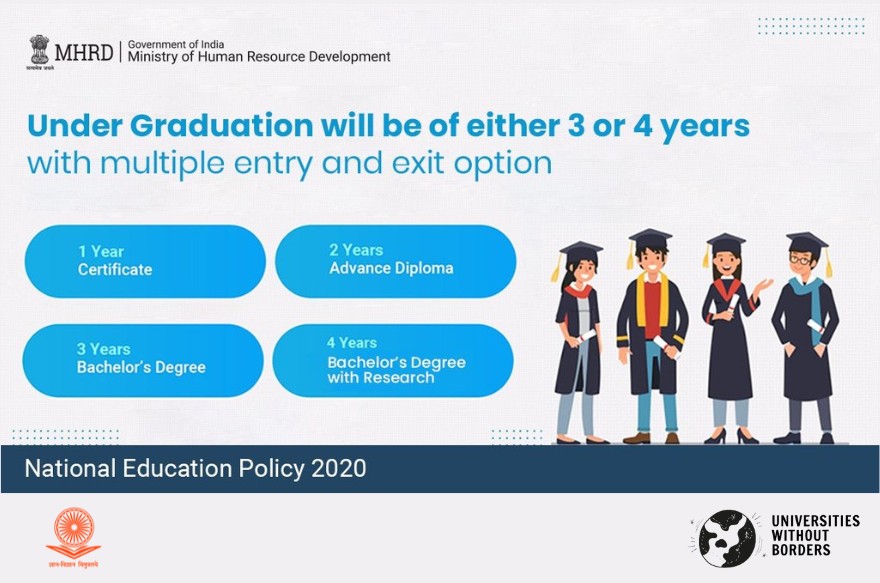
The National Education Policy (NEP) 2020 envisions innovation and flexibility in higher education. It has proposed a new “Curricular Framework” and “Credit System” which revises the “Choice Based Credit System” (CBCS).
Recently, UGC has shared a copy of the Curriculum and Credit Framework for Undergraduate Programmes for implementation in Higher Educational Institutions.
Let’s view the new and revised curricular framework and the credit system in some of its significant aspects:
National Education Policy (NEP) 2020
The NEP acknowledges the role of higher education in promoting human as well as societal well-being in the development of a society and country. It aims to ensure that higher education may help individuals be thoughtful, good, well-rounded, and creative.
NEP (2020): Key Highlights
- NEP 2020 has revised the Choice Based Credit System (CBCS) to instil innovation and flexibility.
- It intends to resolve the issues of credit transfer and equivalence and move towards a criterion-based grading system that will assess student achievement based on the learning goals for each programme.
- It foresees continuous and comprehensive evaluations.
- It supports the Academic Bank of Credit (ABC), which digitally stores the academic credits earned by students from various recognized HEI so their degrees can be awarded taking into account the credits earned.
Undergraduate Programme: New Structure
The new and transformative design of NEP 2020 in higher education is:
- The new policy foresees undergraduate education must develop and provide:
- intellectual, aesthetic, social, physical, emotional, ethical, and moral capacities, in learners, in an integrated manner.
- Soft skills, communication skills, creative thinking, critical thinking, and complex problem-solving skills.
- Rigorous specialization in a chosen field(s) of learning.
- The NEP foresees educational institutes adopting flexible curricular structures to enable creative combinations of subjects and provide study in multidisciplinary contexts. In addition to rigorous specialization in a subject or subjects, the design must allow flexibility in course options.
- Undergraduate degree programmes (3 or 4-year duration) will have multiple entry and exit points and reentry options within the course duration.
- A certificate after completion of 1 year of study.
- A diploma after 2 years of study.
- A bachelor’s degree after the completion of 3-years of study.
- A bachelor’s degree with honours after the completion of 4-years of study.
- A bachelor’s degree with research after the completion of 4-years of study if the student completes a rigorous research project in a major area(s) of study.
The 4-year (8 semesters) multidisciplinary bachelor’s degree programme would provide the students – with an experience of the full range of holistic and multidisciplinary education, and a focus on the chosen major and minors as per the choices of the student.
- The design and duration of Master’s degree programmes will feature flexibility:
- Students who have completed the 3-year bachelor’s degree programme and enrolled for the 2-year master’s degree programme will have the second year dedicated to research.
- The students who have completed a 4-year bachelor’s degree programme with research will have a 1-year master’s degree programme.
- Students can undertake a doctoral programme of study with either a master’s degree or a 4-year bachelor’s degree (with research).
- The curriculum must feature – Global Citizenship Education and education for sustainable development. Learners aware of global and sustainable development issues can become active supporters of tolerant, inclusive, secure, and sustainable societies.
- Students to learn the practical side of their studies and improve their employability may go for internships with local industries, businesses, artists, crafts persons, etc., or go for research internships with faculty and researchers at their own or other HEIs/research institutions.
- Teaching – Languages, Literature, Music, Philosophy, Art, Dance, Theatre, Statistics, Pure and Applied Sciences, and Sports – will ensure a multidisciplinary and stimulating learning environment.
- Undergraduate education may enhance the employability of the youth they are to learn – Artificial Intelligence (AI), 3-D machining, big data analysis, and machine learning, in addition to genomic studies, biotechnology, nanotechnology, and neuroscience.
New Credit System: Main Features
The revised Credit System features flexibility and facilities mainly to allow the learners to choose courses and programmes of their choice:
- It allows moving from one discipline to another, within the course duration, by securing the required credits in the chosen discipline or area of study.
- Learners can choose the subject of their interest.
- Multiple entries and exit options with certificate/diploma / or degree depend upon the number of credits secured.
- Learners can move from one institution to another to avail of multi and interdisciplinary learning.
- Learners can switch to other modes of learning (face-to-face, ODL, online, and hybrid).
Credit Structure
A credit is a unit by which a course is measured. It determines the number of hours required per week during a semester (minimum 15 weeks).
Credit Structure of The Undergraduate Programme
| S. No. | Category of Course | Minimum Credit Requirement | |
| 3-year UG | 4-year UG | ||
| 1. | Major | 60 | 80 |
| 2. | Minor Stream | 24 | 32 |
| 3. | Multidisciplinary | 09 | 09 |
| 4. | Ability Enhancement Courses | 08 | 08 |
| 5. | Skill Enhancement Courses | 09 | 09 |
| 6. | Value Added Courses common for all UG | 06-08 | 06-08 |
| 7. | Summer Internship | 02-04 | 02-04 |
| 8. | Research Project / Dissertation | – | 12 |
| Total | 120 | 160 |
Honours students not undertaking research would do 3 courses for 12 credits in lieu of a research project / Dissertation.
